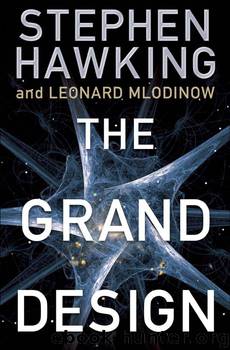The Grand Design by Stephen Hawking

Author:Stephen Hawking [Hawking, Stephen]
Language: eng
Format: epub, mobi
ISBN: 978-0-553-90707-0
Publisher: Random House Publishing Group
Published: 2010-07-25T16:00:00+00:00
The first force for which a quantum version was created was electromagnetism. The quantum theory of the electromagnetic field, called quantum electrodynamics, or QED for short, was developed in the 1940s by Richard Feynman and others, and has become a model for all quantum field theories. As we’ve said, according to classical theories, forces are transmitted by fields. But in quantum field theories the force fields are pictured as being made of various elementary particles called bosons, which are force-carrying particles that fly back and forth between matter particles, transmitting the forces. The matter particles are called fermions. Electrons and quarks are examples of fermions. The photon, or particle of light, is an example of a boson. It is the boson that transmits the electromagnetic force. What happens is that a matter particle, such as an electron, emits a boson, or force particle, and recoils from it, much as a cannon recoils after firing a cannonball. The force particle then collides with another matter particle and is absorbed, changing the motion of that particle. According to QED, all the interactions between charged particles—particles that feel the electromagnetic force—are described in terms of the exchange of photons.
The predictions of QED have been tested and found to match experimental results with great precision. But performing the mathematical calculations required by QED can be difficult. The problem, as we’ll see below, is that when you add to the above framework of particle exchange the quantum requirement that one include all the histories by which an interaction can occur—for example, all the ways the force particles can be exchanged—the mathematics becomes complicated. Fortunately, along with inventing the notion of alternative histories—the way of thinking about quantum theories described in the last chapter—Feynman also developed a neat graphical method of accounting for the different histories, a method that is today applied not just to QED but to all quantum field theories.
Feynman’s graphical method provides a way of visualizing each term in the sum over histories. Those pictures, called Feynman diagrams, are one of the most important tools of modern physics. In QED the sum over all possible histories can be represented as a sum over Feynman diagrams like those below, which represent some of the ways it is possible for two electrons to scatter off each other through the electromagnetic force. In these diagrams the solid lines represent the electrons and the wavy lines represent photons. Time is understood as progressing from bottom to top, and places where lines join correspond to photons being emitted or absorbed by an electron. Diagram (A) represents the two electrons approaching each other, exchanging a photon, and then continuing on their way. That is the simplest way in which two electrons can interact electromagnetically, but we must consider all possible histories. Hence we must also include diagrams like (B). That diagram also pictures two lines coming in—the approaching electrons—and two lines going out—the scattered ones—but in this diagram the electrons exchange two photons before flying off. The diagrams pictured
Download
This site does not store any files on its server. We only index and link to content provided by other sites. Please contact the content providers to delete copyright contents if any and email us, we'll remove relevant links or contents immediately.
Tools of Titans by Timothy Ferriss(8304)
Turbulence by E. J. Noyes(7977)
Secrets of Antigravity Propulsion: Tesla, UFOs, and Classified Aerospace Technology by Ph.D. Paul A. Laviolette(5332)
Astrophysics for People in a Hurry by Neil DeGrasse Tyson(5151)
Room 212 by Kate Stewart(5070)
Design of Trajectory Optimization Approach for Space Maneuver Vehicle Skip Entry Problems by Runqi Chai & Al Savvaris & Antonios Tsourdos & Senchun Chai(5037)
Pale Blue Dot by Carl Sagan(4953)
The David Icke Guide to the Global Conspiracy (and how to end it) by David Icke(4655)
A Journey Through Divination and Astronomy by Publishing Pottermore(4363)
Goodbye Paradise(3761)
Apollo 8 by Jeffrey Kluger(3667)
COSMOS by Carl Sagan(3588)
The Five People You Meet in Heaven by Mitch Albom(3520)
Losing the Nobel Prize by Brian Keating(3518)
How to Read Water: Clues and Patterns from Puddles to the Sea (Natural Navigation) by Tristan Gooley(3431)
Brief Answers to the Big Questions by Stephen Hawking(3392)
How to Read Nature by Tristan Gooley(3290)
The Order of Time by Carlo Rovelli(3162)
A Brief History of Time by Stephen Hawking(2991)
